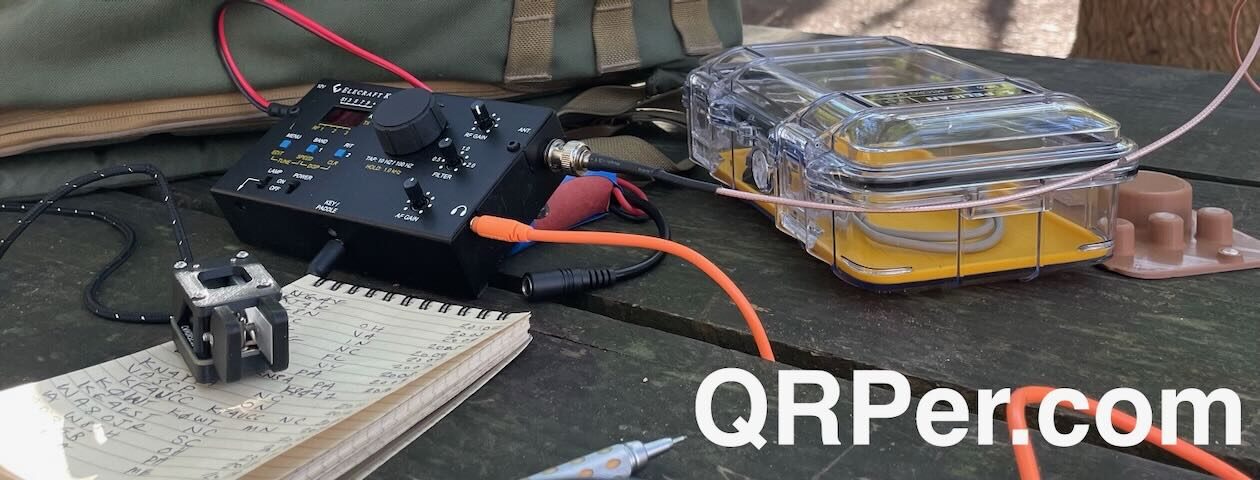On the activator side of things, Parks On The Air is often a solitary pursuit for me. I typically squeeze in activations as my schedule allows—usually at random times during the day in parks that happen to be along my daily route.
But every once in a while, the stars align and I get the chance to activate with a friend. When that happens, it only amplifies the radio fun. Saturday, March 22, 2025, was one of those special days. My dear friend—and frequent field report contributor—Brian (K3ES), along with his amazing wife and photographer, Becky, stopped by Asheville en route to the Outer Banks.
I was so happy everything came together and we were able to meet up for a short, relaxed, and thoroughly enjoyable activation.
Two-Fer Time!
 When out-of-state activators come through the area, I always try to offer them the option of a two-fer—activating two parks at once—to maximize their POTA opportunities. I’m not sure Brian had strong feelings about this either way, but it was simply too easy to pair the Blue Ridge Parkway (US-3378) with the Mountains-to-Sea Trail (US-8313). Since we were meeting at the Folk Art Center, all it took was picking the right picnic table near the MST.
When out-of-state activators come through the area, I always try to offer them the option of a two-fer—activating two parks at once—to maximize their POTA opportunities. I’m not sure Brian had strong feelings about this either way, but it was simply too easy to pair the Blue Ridge Parkway (US-3378) with the Mountains-to-Sea Trail (US-8313). Since we were meeting at the Folk Art Center, all it took was picking the right picnic table near the MST.
In my rush to leave the QTH that morning, I realized halfway down the driveway that I’d forgotten to pack my antenna. I could’ve turned around, but I knew Brian would have a few antenna options stowed in his field kit—and of course, he did!
 He chose to deploy a homebrew end-fed random wire with a 29.5’ radiator and 17’ counterpoise. We paired it with my Elecraft K1 transceiver–a radio I knew Brian had never operated.
He chose to deploy a homebrew end-fed random wire with a 29.5’ radiator and 17’ counterpoise. We paired it with my Elecraft K1 transceiver–a radio I knew Brian had never operated.
 The only drawback of this particular picnic table is its proximity to the Mountains-to-Sea Trail. When deploying a wire antenna, you have to be careful not to obstruct the path for hikers. We positioned the wire in a near-vertical configuration above the table and kept the throw line tucked away on the opposite side from the trail.
The only drawback of this particular picnic table is its proximity to the Mountains-to-Sea Trail. When deploying a wire antenna, you have to be careful not to obstruct the path for hikers. We positioned the wire in a near-vertical configuration above the table and kept the throw line tucked away on the opposite side from the trail.
We were also quite conspicuous—another reason I usually avoid this picnic table when activating solo. On a busy day, it’s not unusual to have a dozen people stop by to ask what you’re up to. It’s a great outreach opportunity, but a string of interruptions can make it difficult to complete exchanges—especially while sending CW. Sadly, my internal CPU isn’t optimized for multitasking!

But when there are two of you taking turns at the key, it works beautifully—one person can handle the questions while the other shows just how cool Morse code still is in the 21st century.
It was a fairly quiet day at the Folk Art Center, but one curious family did stop by to chat with us during Brian’s turn at the key—and I really enjoyed the interaction.
Gear
 Note: All Amazon, CW Morse, ABR, Chelegance, eBay, and Radioddity links are affiliate links that support QRPer.com at no cost to you.
Note: All Amazon, CW Morse, ABR, Chelegance, eBay, and Radioddity links are affiliate links that support QRPer.com at no cost to you.
Radio
- Elecraft K1 (four band version with optional ATU and internal AA battery pack)
Key
- UMPP-1 Paddles by GM0EUL
- Senrog Bench Block base
- Key cable: Cable Matters 2-Pack Gold-Plated Retractable Aux Cable – 2.5 Feet
Antenna and Throw Line
- K3ES Homebrew 29.5′ End-Fed Random Wire with 17′ Counterpoise
- 15 ft RG-316 feedline with BNC male connectors at each end
- Weaver arborist throw line/weight and storage bag
Pack and Case
Logging Supplies
Battery
Camera/Audio Gear
- DJI OSMO 4 action camera with Joby Telepod Sport Tripod
- DJI Wireless Microphones
On The Air
 Brian kicked things off, knowing that band conditions had been flaky of late. He tuned up on 20 meters using the K1’s ATU and started calling CQ POTA. Continue reading QRP with Friends: Brian (K3ES) Joins Me for a Two-Fer POTA Activation!
Brian kicked things off, knowing that band conditions had been flaky of late. He tuned up on 20 meters using the K1’s ATU and started calling CQ POTA. Continue reading QRP with Friends: Brian (K3ES) Joins Me for a Two-Fer POTA Activation!



































